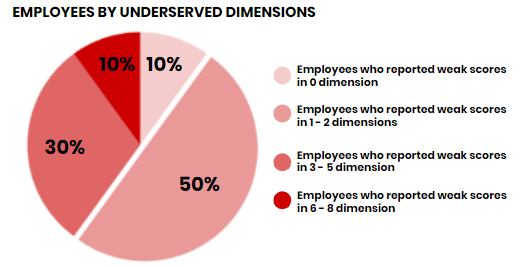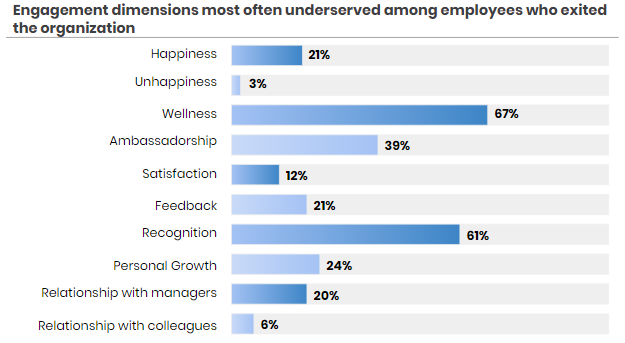Which dimensions of employee engagement explain why employees leave their organizations?
What is Employee Engagement?
Employee engagement is the art and science of engaging people in authentic and recognized connections to strategy, roles, performance, organization, community, relationship, customers, development, energy, and happiness to leverage, sustain, and transform work into results." ― David Zinger [1]
William Kahn from Boston University coined the term employee engagement with his groundbreaking research 30 years ago [2]. His concept of the engaged employee was of one who finds the job motivating, is committed to the assignment, and engages in meaningful professional relationships with other members of the organization.
Since Kahn’s original publication, considerable research has been pursued to further refine our understanding of employee engagement.
The measurement of employee engagement has been a challenge that has attracted the attention of researchers and business leaders alike. Quality of Work Life: Scale Development and Validation [3] is a review of 24 studies on this topic, qualifying employee engagement into nine dimensions of work-life. The dimensions we consider here expand on this academic work for the benefit of business leaders.
We studied responses from Happily Pulse Surveys (pulse surveys are lightweight employee engagement surveys that are sent out on a daily or weekly basis). The surveys cover nine engagement dimensions that measure the quality of work life (QWL). These dimensions provide a structure and guide for business leaders to consider when creating their own engagement surveys.
Two of the most common use cases for studying employee engagement data are when an organization is looking to:
- improve productivity or
- address the problem of employee turnover
Improvements to these cases impact the bottom line through greater revenue growth and cost savings[4]. We’ll address the cost savings side of the ledger here.
We demonstrate how to use employee engagement data collected from employees who exited an organization to diagnose which QWL dimension has the largest impact on employee turnover. To do this, we studied pulse survey data from exited employees collected over a year.
Our study: The effect of employee engagement on employees exiting an organization
We studied a group of 73 employees who left their organizations to determine which underserved QWL dimensions (weak scores) may have contributed to their exit*:
- 7 of 73 subjects did not present weak scores in any QWL dimensions
- 66 of 73 subjects reported weak scores in at least 1 QWL dimension
- 2 of 73 subjects reported weak scores across 8 different QWL dimensions
*includes both voluntary and involuntary turnover
Among the group of 73 employees, around half (37 out 73) reported weak scores in just one or two QWL dimensions suggesting that it doesn’t take much for an employee to become disengaged enough to leave an organization.
Our findings also show 13 of 44 employees who reported weak scores in at least two dimensions reported weak scores in the “Relationship with Manager” QWL dimension as well.
Furthermore, 13 out of 13 employees (100%) who reported weak scores in the “Relationship with Manager” QWL dimension also exhibited weak scores in the “Recognition” QWL dimension. There is a strong correlation between the “Relationship with Manager” and “Recognition” dimensions, which we will explore further as we expand our study to larger populations.

Among employees who reported weak scores in at least one QWL dimension, the top three that affected employees most were Wellness (67%), Recognition (61%), and Ambassadorship (39%).

Strategy to retain employees
Our results suggest that we should take a closer look at Wellness and Recognition in our workplaces. For recognition, we may consider how non-monetary recognition can be implemented and how middle managers can play a bigger role in giving and facilitating recognition in their teams. A one-off audit of a recognition program can provide insights that, when properly addressed, can have a big impact on reducing employee turnover.
Wellness, in this case, refers to how stressed or overwhelmed an employee feels at work at any point in time. It can be challenging to identify overburdened employees without pulse surveys, but having the right communication strategies in place (eg. regular 1-on-1 meetings between managers and their direct reports) can go a long way to alleviate the problem before it escalates. Resolving wellness issues among your employees is likely to be the single biggest contributor to improving retention resulting in significant cost savings, and most importantly having fully engaged employees in your workplace.
A Culture of Engaged Employees
Research tells us that all Quality of Work-life dimensions are important towards creating employee engagement. Studying your employee engagement data can help you prioritize interventions that would provide the biggest impact. If you’re without data but want to get started, improvements to your Recognition and Wellness programs should be a priority so that you can drive outsized improvements to your employee engagement, productivity, and employee retention.
It’s clear why engaged employees are highly energized and resilient. They pour their heart and soul into their job; exhibit strong work involvement; and experience feelings of significance, passion, and excitement [5]. You can build such a culture one step at a time, beginning with understanding your own data. We’d love to help you better understand your employees!
Happily is a one-of-a-kind platform that drives unprecedented feedback, recognition, insights, coaching, and more. Visit our website to learn more, request a demo, and be on your way to engaging your workforce talent consistently!
References:
[1] Let’s Co-Create an Employee Engagement Charter, The Employee Engagement Network
[2] https://donrheem.com/william-kahn-father-of-employee-engagement/
[3]https://www.internationaljournalofcaringsciences.org/docs/6_swamy.pdf
[4] https://www.gnapartners.com/article/how-much-does-employee-turnover-really-cost-your-business/
[5] Jena, Lalatendu & Pradhan, Sajeet. (2017). Research and Recommendations for Employee Engagement Revisiting the Employee-organization Linkage. Development and Learning in Organizations. 31. 17–19. 10.1108/DLO-02–2017–0012.
[6] Photo by Gilbert Beltran on Unsplash









